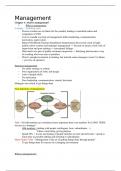Samenvatting
Summary - Management (HBA03C)
- Instelling
- Katholieke Universiteit Leuven (KU Leuven)
This is an executive summary of Prof. Annick Vanrossem's management course in the first year of BBA. All the information from the slides and my extra notes are in this document.
[Meer zien]












